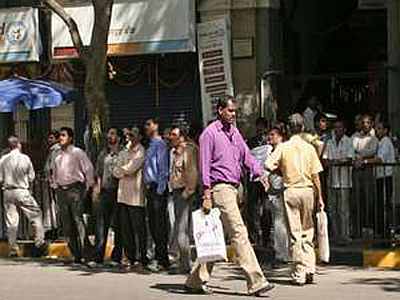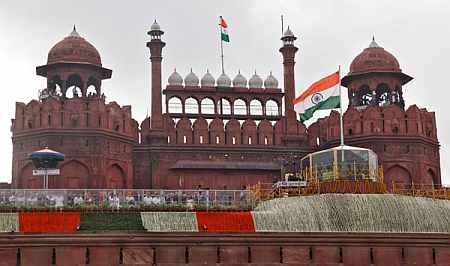Photographs: B Mathur/Reuters Subir Roy in New Delhi
As India has fallen off the high-growth path that it travelled for five years (2003-08) to considerable global acclaim, economists have focused on the prerequisites of high growth, to highlight what needs doing to again be among the global good and the great.
At a time when growth will be around 6.5 per cent, some experts say that with right policies the country can go back to eight to nine per cent growth.
High growth can enable a quick journey out of poverty since it creates buoyant tax revenue and allows significant transfers to the poor. Those who believe in it feel that even if its benefits reach the top first, they eventually trickle down.
...
Why high growth is not a perfect solution for an economy
Photographs: Reuters
Also, high growth is usually accompanied by an open mindset that promotes modern, forward-looking policies.
The prospects of high returns induced by high growth serve to bring in foreign investment -- which, in turn, keeps the growth momentum going.
Important as high growth is, should it be seen as an end in itself or an enabler? Can there be aspects of high growth that do not deliver the ultimate aims?
In India, where large numbers of poor suffer from serious deprivation, the cardinal aim has to be meaningful lives for all, with enough to eat, reasonably good health, minimum skills to get productive jobs and enough jobs to go around -- all this while not ruining the environment.
...
Why high growth is not a perfect solution for an economy
Photographs: Reuters
But India is in the unfortunate position of suffering from a very serious non-material deficit -- in governance and minimum standards in public life. India has now entered the middle-income country group but features poorly in global corruption league tables.
If the benefits of public programmes barely reach the poor, then surely a rupee of leakage saved is as good as a rupee collected in taxes.
High growth leads to high incomes, but what if lower growth does just as well with better delivery, without some of the downside of high growth?
...
Why high growth is not a perfect solution for an economy
Photographs: Rupak De Chowdhuri/Reuters
The problem of governance is not restricted to the public sector -- the creaming off by the political class and officialdom.
State-aided health insurance schemes have been launched to marry private delivery with public funding, but there are reports of unnecessary caesarian section deliveries and hysterectomies.
High growth is seen to be predominantly private sector-driven, but the public and private sectors often function synergistically. Private medical ethics are highest in Tamil Nadu and Kerala -- these states also have the best public healthcare systems.
...
Why high growth is not a perfect solution for an economy
Photographs: Babu/Reuters
A well-functioning public healthcare system keeps a check on private healthcare costs. In those two states, you can have a better quality of life through affordable healthcare, and so manage with lower incomes. The same arguments hold for education.
China and East Asia achieved high levels of social capital with relatively low levels of public expenditure before they embarked on a high-growth path.
In fact, a healthy, educated citizenry launched them on the high-growth path. India laid the foundations of a knowledge economy in the '60s and '70s -- before the era of high growth.
A schoolteacher or nurse in Bangladesh earns less than her Indian counterpart but delivers the same social value. In relation to India, Bangladesh has made some credible human development gains despite being poorer.
...
Why high growth is not a perfect solution for an economy
Photographs: Reuters/Babu
Owning a car is aspirational in India and China, but it comes with higher pollution and respiratory ailments for many. In the post-liberalisation era, in both countries the cost of healthcare and housing has marched way ahead of rising real incomes.
Per capita real incomes growing at five per cent or more are great, but do they necessarily translate into a commensurate improvement in the quality of life?
High growth in India and China has raised income inequality when low income inequality, which strengthens fraternity, is considered an end in itself. Japan and East Asia have managed to marry relatively low income inequality with high growth and benefited greatly.
...
Why high growth is not a perfect solution for an economy
Photographs: Reuters
Their social gains from growth have been far higher than those achieved by high-growth episodes in Latin America. Can we say it is not good to grow too fast if that produces too much inequality?
Lastly, environmental sustainability has posed the biggest question mark over the future of high growth. Highly polluting high growth is out, as is resource-intensive growth. Commodity price cycles are unlikely to allow again a long period of global growth of the sort that ended in 2009.
India's high-growth phase coincided with the global boom and ended when oil prices spiked in 2008 and brought inflation in its wake. So, high growth is a good thing to have -- but it is neither an absolute must nor enough to have a good life.









article